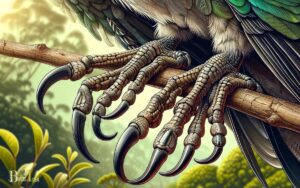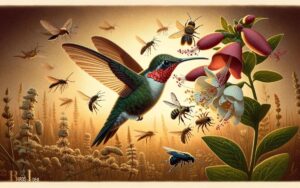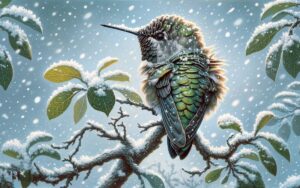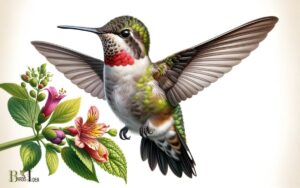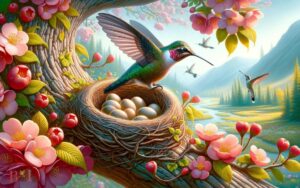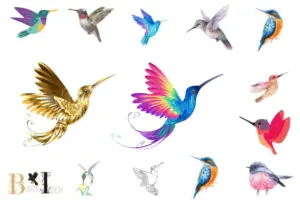Types of Hummingbirds in Seattle: Anna’s, Rufous!
Seattle, Washington, is home to a diverse range of hummingbird species, primarily the Anna’s Hummingbird and the Rufous Hummingbird.
Anna’s Hummingbirds are year-round residents, while Rufous Hummingbirds are migratory and can be seen during their movement to breeding grounds in spring and back to wintering areas in late summer and fall.
Hummingbirds are a delight to observe, and the types you’ll find in Seattle offer a small but vibrant snapshot of this bird family.
Here are key details about the two primary hummingbird species found in Seattle:

Key Takeaway
Anna’s Hummingbird
The Anna’s Hummingbird is a common sight in Seattle’s gardens and wooded areas. This species, scientifically known as Calypte anna, belongs to the Trochilidae family within the Apodiformes order.
The male Anna’s Hummingbird is distinguished by its iridescent rose-red crown and gorget, while the female exhibits a green iridescent back and pale gray underparts.
These hummingbirds are known for their agility in flight, achieved through rapid wingbeats and impressive aerial maneuvers. They primarily feed on nectar from various flowering plants, using their specialized long, tubular tongues.
Additionally, they consume small insects and spiders for protein. Their breeding season typically spans from December to July, and they construct compact cup-shaped nests using plant down, spider silk, and other materials.
The Anna’s Hummingbird’s adaptability and vibrant presence make it a beloved fixture in Seattle’s natural landscape.
Rufous Hummingbird
With its fiery plumage and remarkable migration patterns, the Rufous Hummingbird is another notable species found in the Seattle area.
This species, scientifically known as Selasphorus rufus, is a striking sight with its vibrant orange-red throat and back, making it easily distinguishable from other hummingbird species.
- Migration: Rufous Hummingbirds travel over 3,000 miles from their breeding grounds in the Pacific Northwest to their wintering grounds in Mexico.
- Feeding: They primarily feed on nectar from tubular flowers and are known for their aggressive nature in defending feeding territories.
- Breeding: Males perform elaborate aerial courtship displays to attract females, and the female is solely responsible for building the nest and raising the young.
- Conservation: Their population is currently stable, but conservation efforts are essential due to habitat loss and potential impacts of climate change.
Calliope Hummingbird
The Calliope Hummingbird (Selasphorus calliope) is known for its unique physical characteristics, such as the iridescent pink throat patch on the males and the tiny size of both sexes, making it the smallest breeding bird in North America.
This species is often found in mountainous regions with meadows, shrubby areas, and open woodlands, where it constructs its nest using plant fibers, spider silk, and lichens, often incorporating feathers and bark for camouflage.
Calliope Hummingbirds display a distinct feeding and migration pattern, primarily foraging on nectar from flowers and occasionally catching insects in flight, while migrating from their breeding grounds in the western United States to their wintering grounds in Mexico and Central America.
Unique Physical Characteristics
Exhibiting distinctive physical features, the Calliope Hummingbird is renowned for its vibrant plumage and diminutive size.
This species, found in Seattle, possesses unique characteristics that distinguish it from other hummingbirds:
- Plumage: The male Calliope Hummingbird is adorned with iridescent magenta-red throat feathers, known as a gorget, which is a distinguishing feature during the breeding season.
- Size: It is the smallest breeding bird in North America, measuring merely 3 inches in length and weighing about as much as a ping-pong ball.
- Tail feathers: The male Calliope Hummingbird has elongated outer tail feathers that emit a distinct chirping sound during courtship displays and territorial defense.
- Range: Calliope Hummingbirds have the northernmost breeding range of any hummingbird, often venturing into high mountain meadows during the summer.
These unique physical attributes make the Calliope Hummingbird a fascinating and sought-after species for birdwatchers in the Seattle area.
Preferred Nesting Habitats
Amidst the diverse avian landscape of Seattle, the Calliope Hummingbird selects its nesting habitats with precision and preference.
This diminutive species, known for its iridescent gorget and compact size, exhibits a strong affinity for mountainous regions, particularly coniferous forests and alpine meadows.
The Calliope Hummingbird displays a marked inclination towards nesting in close proximity to clearings or edges within these habitats, where they can capitalize on the availability of nectar-rich flowers and the associated abundance of insect prey.
Furthermore, this species demonstrates a predilection for nesting in shrubby vegetation, often favoring the protective cover provided by willows, alders, and other small trees.
Such nesting habitat preferences align with the Calliope Hummingbird’s foraging behaviors and underscore its adaptation to the unique ecological niches found within Seattle’s natural landscapes.
Feeding and Migration Patterns
With a preference for mountainous regions and shrubby vegetation, the Calliope Hummingbird’s feeding and migration patterns are characterized by precision and adaptability within Seattle’s diverse ecological landscapes.
- Feeding Habits: Calliope Hummingbirds primarily feed on nectar from brightly colored tubular flowers such as penstemon, columbine, and wild currant. They also catch insects in mid-air for protein, essential for their breeding season.
- Migration: These hummingbirds are known for their remarkable migration, traveling from their breeding grounds in the Pacific Northwest to wintering grounds in Mexico.
- Adaptability: Calliope Hummingbirds display adaptability by utilizing backyard feeders filled with sugar water, especially during the critical periods of early spring and late summer when natural nectar sources are scarce.
- Conservation Status: Due to habitat loss and climate change, Calliope Hummingbirds are vulnerable, emphasizing the importance of preserving their diverse habitats.
The Calliope Hummingbird’s remarkable feeding and migration patterns set the stage for understanding the behavior of the black-chinned hummingbird.
Black-chinned Hummingbird
The Black-chinned Hummingbird, scientifically known as Archilochus alexandri, is distinguished by its unique mating dances, which involve intricate aerial displays and vocalizations.
Males possess a distinctive black chin patch, which aids in visual identification and is a key characteristic of the species.
This species is commonly found in open woodlands, scrublands, and desert oases, and exhibits a wide range across the western United States and parts of Mexico.
Unique Mating Dances
The Black-chinned Hummingbird exhibits a distinctive mating dance that is unique among the hummingbird species in Seattle.
This intricate courtship ritual involves several remarkable behaviors:
- Aerial displays: The male Black-chinned Hummingbird performs impressive aerial acrobatics, including rapid dives and steep ascents, to showcase its agility and attract a mate.
- Tail feather flashing: During the courtship display, the male flashes its iridescent tail feathers, creating shimmering visual effects to captivate the female.
- Vocalizations: The male accompanies its aerial displays with melodious chirps and trills, producing a symphony of sounds to complement its visual spectacle.
- Perch performances: In addition to aerial displays, the male may also perform captivating dances and movements while perched, further demonstrating its prowess and desirability to potential mates.
These behaviors collectively form a compelling and unique mating dance that distinguishes the Black-chinned Hummingbird.
Distinctive Black Chin
Exhibiting a distinctive feature, the Black-chinned Hummingbird’s black chin sets it apart from other hummingbird species in Seattle.
Taxonomically classified as Archilochus alexandri, this species is characterized by its iridescent green back and crown, white underparts, and, most notably, the black patch on its chin that gleams purple when the light hits it.
The black chin is a prominent trait in both males and females, although it may be less visible in females.
This plumage feature is crucial for identifying and distinguishing the Black-chinned Hummingbird from other similar species in the region.
The black chin serves as an important marker for ornithologists and bird enthusiasts when observing and documenting the presence of this species in Seattle.
Range and Habitat
Thriving in the diverse flora of Seattle, the Black-chinned Hummingbird inhabits a range of habitats, utilizing various nectar sources and nesting in trees and shrubs.
This species demonstrates a preference for specific environmental conditions, including:
- Forest Edges: Black-chinned Hummingbirds are commonly found near the edges of forests, where they can access both open spaces and the cover of trees for nesting and foraging.
- Urban Gardens: They are also known to frequent urban and suburban areas, attracted to gardens with a variety of flowering plants that provide abundant nectar.
- Riparian Habitats: Along rivers and streams, these hummingbirds can be observed seeking out flowers along the water’s edge, often favoring willows and other flowering shrubs.
- Mountainous Regions: In Seattle, they are frequently spotted in higher elevation areas, displaying a preference for mountain meadows and open woodlands.
Allen’s Hummingbird
Among the various types of hummingbirds in Seattle, the Allen’s Hummingbird is known for its vibrant plumage and distinctive mating displays.
Scientifically classified as Selasphorus sasin, this species is characterized by its iridescent green back and vivid rufous-orange flanks. The male’s gorget, a patch of iridescent throat feathers, reflects a brilliant orange-red when caught in the sunlight.
Allen’s Hummingbirds are renowned for their agile flight and are often observed performing intricate aerial displays during courtship.
They primarily inhabit coastal regions, but during migration, they can be found in a variety of habitats, from chaparral and woodland edges to urban gardens.
Understanding the behavior and ecological requirements of the Allen’s Hummingbird is crucial for conservation efforts in Seattle.
Broad-tailed Hummingbird
The foraging behavior of the Broad-tailed Hummingbird is a key aspect of its ecological role in the Seattle area.
This species, identified by its vibrant green plumage and iridescent rose-red throat patch, exhibits fascinating behaviors that contribute to the local ecosystem.
Here are some noteworthy foraging habits of the Broad-tailed Hummingbird:
- Traplining: These hummingbirds engage in traplining, where they visit a specific sequence of flowers, often in a consistent order, to efficiently collect nectar.
- Hover-Feeding: They are adept at hover-feeding, using their remarkable agility to extract nectar from flowers while hovering in mid-air.
- Aggressive Defense: Broad-tailed Hummingbirds fiercely defend their feeding territories, often engaging in aerial chases and vocal displays to protect their food sources.
- Long-Distance Migration: This species migrates over long distances, with some individuals traveling as far as Central America during the winter months.
Costa’s Hummingbird
Frequently observed in the Seattle area, the Costa’s Hummingbird exhibits distinctive foraging behaviors that contribute to the local ecosystem.
Scientifically known as Calypte costae, this species belongs to the Trochilidae family and the Apodiformes order.
Identified by its iridescent purple crown and elongated throat feathers, the male Costa’s Hummingbird performs impressive aerial displays to attract mates.
With a preference for desert scrub and arid habitats, it is a rare visitor to the Seattle region, often observed in urban gardens and parks. Its specialized long, slender bill allows it to access nectar from tubular flowers, making it an essential pollinator.
The Costa’s Hummingbird plays a crucial role in maintaining floral diversity and ecosystem balance.
Buff-bellied Hummingbird
Native to the Seattle region, the Buff-bellied Hummingbird, scientifically known as Amazilia yucatanensis, presents another captivating species that contributes to the diverse hummingbird population in the area.
This species is known for its distinct features and behaviors, making it a fascinating subject for bird enthusiasts and researchers alike.
Here are key characteristics of the Buff-bellied Hummingbird:
- Distinctive Appearance: The male Buff-bellied Hummingbird exhibits vibrant green plumage with a buff-colored lower belly, while the female has a more subdued coloration.
- Unique Feeding Habits: These hummingbirds are known to feed on nectar from a variety of flowers and are also attracted to sugar water feeders.
- Migratory Patterns: During the breeding season, they can be found in the southern United States and Mexico, and they migrate to the Gulf Coast in winter.
- Vocalizations: Their vocalizations consist of high-pitched, chattering calls, often used during courtship and territorial displays.
The Buff-bellied Hummingbird’s remarkable characteristics make it an essential part of Seattle’s hummingbird population.
Violet-green Swallow
A notable avian species found in the Seattle region is the Violet-green Swallow, known for its distinctive iridescent plumage and graceful aerial acrobatics.
Taxonomically, it belongs to the family Hirundinidae and the genus Tachycineta. With its metallic green back, violet rump, and white underparts, this species exhibits sexual dimorphism, where males showcase longer outer tail feathers.
The Violet-green Swallow primarily inhabits open woodlands, riparian areas, and mountainous regions.
During the breeding season, it constructs cup-shaped nests in tree cavities or artificial nest boxes.
Feeding predominantly on flying insects, it forages in flight with agile maneuvers, utilizing its wide gape to capture prey.
This species migrates to Central America during the winter, making it a captivating and vital component of the avifauna in the Seattle area.
Conclusion
Seattle is home to a diverse array of hummingbird species, including the Anna’s, Rufous, Calliope, Black-chinned, Allen’s, Broad-tailed, Costa’s, and Buff-bellied Hummingbirds, as well as the Violet-green Swallow.
These tiny, iridescent creatures bring vibrant colors and energetic movement to the local ecosystem, contributing to the rich biodiversity of the region.
Their unique characteristics and behaviors make them a fascinating subject for observation and study in the field of ornithology.

